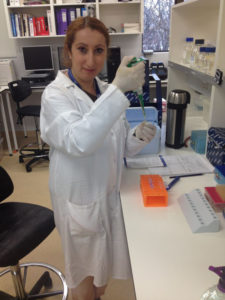

Perplexing Citrus Pathogens
June 21, 2015

Dr Azza Rhaiem from the National Gene Bank (NGB) in Tunisia recently received training in identifying fungal plant
pathogens and establishing of fungal cultures at The University of Melbourne.
The NGB has a mandate to preserve biological diversity and protect genetic resources, boost scientific research in agricultural biotechnology and promote sustainable genetic diversity for research into plant breeding and crop improvement.
A major focus of the NGB is the establishment of a fungal culture collection which will underpin the development of a fungal diagnostic program to detect and identify pathogens that cause major foliar and soil-borne diseases of
important agricultural and horticultural plants in Tunisia.
As in Australia, plant disease diagnosis is fundamental to developing quarantine and biosecurity protocols to mitigate the risk of incursion of exotic pathogens. In Tunisia, citrus fruit production is an important local and export crop which is susceptible to many fungal diseases, including anthracnose disease which has only recently been observed in Tunisia. Anthracnose is also an important post harvest disease of citrus grown in Australia and is mainly controlled by use of fungicides during warm and humid growing conditions.
The efficacy of appropriate control methods depends on correct identification of the species of fungal pathogens that causes the disease. Anthracnose disease is caused by Colletotrichum species which are difficult to identify based on morphological characters with accurate identification depending on molecular identification.
This training award enabled Dr Rhaiem to learn the traditional and modern molecular methods for identifying Colletotrichum species. “Precise identification of the Colletotrichum spp that cause anthracnose disease of citrus will enable early detection of the pathogen in Tunisia and prevent its spread to other regions in the country,” Dr Rhaiem said.
Isolates of Colletotrichum cultured from citrus trees grown in Tunisia were sent to an AQIS registered quarantine laboratory at the University of Melbourne. These isolates were also compared to a few isolates from citrus trees in Queensland, Australia. Specific fungal genes were sequenced and compared to sequences of reference isolates in international data bases. A strong collaborative link has now been established between Prof Paul Taylor’s research group at the University of Melbourne and the National Gene Bank in Tunisia.
An interesting outcome of the training was the identification of several, possibly new undescribed Colletotrichum species both in Tunisia and Australia that will require further analysis. These results have biosecurity implications for both the Tunisian and Australian citrus industries.




